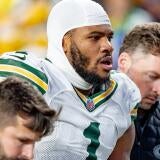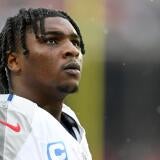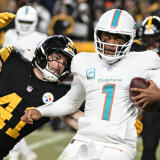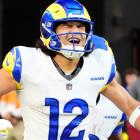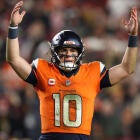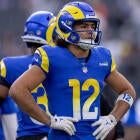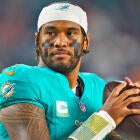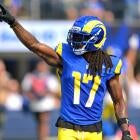Grading 2020 NFL offenses: 11 above-average teams that fall just short of the elite tier
Our weighted grading system sizes up every team's offense, here with those ranked 6-17
More and more in recent seasons, it's become clear that the most important thing in the modern NFL is offensive infrastructure. Offense has been more important than defense for a while now, and the personnel involved in crafting that offense matters a great deal when it comes to determining its success.
Who is your quarterback? Who is protecting him? Who does he throw to? Who does he have next to him in the backfield? Who's scheming those players open? All the pieces matter. The degree to which they matter varies greatly, of course, but each plays a role in making an offense hum at peak efficiency.
All of this brings us to the following project: ranking the offensive infrastructure of all 32 NFL teams. To go about this, we used a weighted grading system where each team was given a 1-5 ranking (1 = terrible, 5 = elite) in the following areas: Quarterback, Offensive Line, Pass-Catchers (WR/TE), Running Backs, and Play-Caller (head coach or offensive coordinator).
Those scores were then weighted so that quarterback was the most important component of the offense, followed by offensive line, play-caller, pass-catchers, and then finally running backs, so that the weights reflected as closely as possible the reality of the way modern NFL offenses really work. We'll run through these rankings in this space over the next few days. Earlier this week we began by examining the lowest-ranking tier in the NFL and the teams with below-average overall units. Today, we'll continue with the offenses that should be above-average or better, but fall short of having everything they need to be considered elite.
17. Minnesota Vikings (3.53)
Grades: QB: 4, OL: 3, Play-caller: 4, WR/TE: 2, RB: 5, Total: 18
The Vikings are down two important pieces from last year's offense, but only one of them has been adequately replaced. Former offensive coordinator Kevin Stefanski is now with the Browns, but the principles of his zone-based running scheme and play-action heavy offense should remain in place and Gary Kubiak should do a perfectly fine job of calling the plays. After trading Stefon Diggs to the next team on our list, though, the Vikes are left with a considerably below-average group of pass-catchers that counts Adam Thielen as its only truly dangerous threat.
Kirk Cousins had a fantastic 2019 season, but with two major contributors to that season now gone, it's tough to count on a repeat. That's especially the case when you consider how poorly Cousins began the season, and that he did not take off until Stefanski made more of a commitment to passing the ball in general, and out of play-action specifically. If Mike Zimmer is able to impose more of a run-heavy philosophy on Kubiak, as he did early last year, that could affect Cousins' performance.
All that said, the Vikings do have one of the NFL's best one-two punches at running back with Dalvin Cook and Alexander Mattison. They each are capable of making defenders miss and creating splash plays, and Cook is also a fantastic receiver out of the backfield. If they could ever get above-average blocking up front, they would be even more effective. Minnesota's offensive line is better than it was a couple of years ago, but still needs upgrades to be considered a truly positive force.
16. Buffalo Bills (3.60)
Grades: QB: 3, OL: 4, Play-caller: 4, WR/TE: 4, RB: 3, Total: 18
Josh Allen took a step forward last season, and that was encouraging to see; but he still did not reach even an average level of quarterback play. He completed passes at a below-average rate, averaged fewer yards per attempt than the average quarterback, was sacked more often than an average passer, and saw his throws turn into touchdowns less often than the average pass in 2019. He showed an ability to take care of the ball by limiting interceptions far more consistently than he had as a rookie and he again did excellent work as a runner, but in the most important parts of the job, he fell a bit short.
Lucky for him, the Bills have made extreme investments in their offensive infrastructure over the past two years, and have upgraded both their offensive line and their pass-catching corps from below-average units to above-average ones during that time. The signings of John Brown, Cole Beasley, Quinton Spain, and Mitch Morse were a good start, and the drafting of Cody Ford helps as well. They put the cherry on top by trading for Stefon Diggs earlier this offseason, giving Allen a true No. 1 target on the perimeter and pushing Brown and into the complementary roles to which they are more suited.
Offensive coordinator Brian Daboll did an excellent job of putting Allen in position to succeed last season, and with more dynamic threats to work with this year should do an even better job. If the Bills actually let Devin Singletary handle the bulk of the work out of the backfield they could jump even higher on this list, but given the way that Sean McDermott and Brandon Beane have spoken about the situation we should expect them to find a complement to him at some point.
T-12. Indianapolis Colts (3.67)
Grades: QB: 4, OL: 4, Play-caller: 4, WR/TE: 2, RB: 3, Total: 17
The 2020 Colts will feature a reunion between Philip Rivers and his former offensive coordinator in San Diego, Frank Reich. During the two years they were previously together, Rivers averaged 4,500 yards and 30 touchdowns per season. If the Colts can tap back into that same type of production, it's safe to say their money will have been well-spent.
Rivers is coming off a disappointing season in LA, but much of his backslide can be attributed to poor offensive line play and a willingness to put the ball up for grabs in situations where the game was no longer really in doubt, in an effort to create big plays. The Colts' offense, meanwhile, looked pretty good early last season, before Jacoby Brissett's own performance fell off due to a midseason knee injury and the complete collapse of his pass-catching corps.
It's still a bit worrisome that the Colts don't have many reliable targets beyond T.Y. Hilton, but perhaps Rivers can find some chemistry with the likes of Zach Pascal, help Parris Campbell take a step forward, or figure out a way to better and more consistently utilize guys like Jack Doyle and Nyheim Hines. At the very least, he should be afforded better protection than he was during his final few years with the Chargers, allowing him more time to pick out receivers down the field.
T-12. Detroit Lions (3.67)
Grades: QB: 4, OL: 3, Play-caller: 4, WR/TE: 4, RB: 3, Total: 18
Given the way the stretch run of the season went, it's easy to forget that Matthew Stafford was rolling early on, and he had the Lions looking like a pretty good offense at the time he went down with an injury.
Through eight games, Stafford had completed 64 percent of his passes and was averaging a career-best 8.6 yards per attempt as offensive coordinator Darrell Bevell designed a system that took advantage of Stafford's ability to push the ball downfield to receivers Kenny Golladay and Marvin Jones Jr. Stafford has one of the strongest arms in the NFL but under Jim Bob Cooter's coordination, the Detroit offense had become almost entirely based around short, quick timing patterns. Bevell opened things up and Stafford benefited from it.
With all four of those key pieces returning in 2020, it's reasonable to expect Stafford to pick up right where he left off. The Lions should also be able to do a better job of incorporating dynamic tight end T.J. Hockenson than they did during his rookie season, which will give Stafford an additional field-stretching weapon over the middle.
The offensive line in front of him, though, remains a bit of an issue, especially after the team let Rick Wagner and Graham Glasgow walk and showered Halapoulivaati Vaitai with an incomprehensibly-large contract. Frank Ragnow and Taylor Decker are two solid pieces for the line but if Detroit wants to keep Stafford upright, there should be an effort made to find another piece for the offensive line in the draft. The Lions would also do well to just commit to Kerryon Johnson as their main running back rather than trying to force themselves into a Patriots-like timeshare system because they do not have the pieces to make that kind of thing work and Johnson has the versatility to play a three-down role anyway.
T-12. Green Bay Packers (3.67)
Grades: QB: 4, OL: 4, Play-caller: 3, WR/TE: 3, RB: 4, Total: 18
It should no longer be controversial to say that Aaron Rodgers is not the same player he once was. That's not to say he's bad or even average. He's still good. He's just not so good that he can overcome any deficiencies in the infrastructure around him, no matter what. He needs at least a little bit of help. And that's fine, especially considering he is still capable of making throws nobody else in the world can make -- even at age 37.
Rodgers could stand to be a bit more aggressive than he has been over the past couple of seasons, though. His minuscule interception totals reflect his ability to protect the football, but he has become far too prone to throwing the ball away if there is even the slightest chance that the throw he wants isn't there. With his arm talent, he should be comfortable taking more risks in an effort to push the ball toward the end zone. His 4.4 percent touchdown rate over the past two seasons is far from the 6.5 percent mark he'd posted in his previous 10 years as a starter, and that lack of aggression plays a major role in the drop-off.
The Packers, though, do need to get him some more help. Davante Adams is possibly the most underrated player in the league and Aaron Jones is a dynamic threat with the ball in his hands, but as we saw last season, the cupboard of playmakers is almost completely bare beyond them. The Packers were outbid for the free agents in this year's tight end class and will likely be counting on Jace Sternberger at that spot, so they will absolutely need to land a wideout early in the draft as a complement to Adams on the outside.
With a strong offensive line in place and a solid system, Matt LaFleur should hopefully be able to take a step forward as a play-caller in 2020. We can't really tell just yet if the pass offense was held back by the poor weaponry, the relative drop-off in Rodgers' play, or the quarterback and coach not necessarily being completely on the same page. This season will tell us a whole lot.
T-12. Seattle Seahawks (3.67)
Grades: QB: 5, OL: 3, Play-caller: 2, WR/TE: 4, RB: 4, Total: 18
It is a downright shame that Russell Wilson has been saddled with an organization that struggles to identify competent offensive linemen and a coaching staff that insists on both centering the offense around the running game and making overly-conservative decisions at almost all times. Wilson alone should guarantee a top-10 offense. It's only through sheer [redacted] that the Seahawks rank this low.
T-10. Atlanta Falcons (3.73)
Grades: QB: 4, OL: 4, Play-caller: 3, WR/TE: 4, RB: 3, Total: 18
The Falcons made an effort last offseason to upgrade their offensive line, only to see it crumble under the weight of injuries in 2019. As a result, Matt Ryan was sacked a league-high 48 times and saw his personal sack rate rocket to a career-high 7.2 percent. That's the bad. This is the good: despite being under constant pressure, Ryan found a way to pilot a strong offense anyway. That's the benefit of having Julio Jones, Calvin Ridley, and Austin Hooper at your disposal.
Hooper is gone now after having signed a sizable deal with the Browns. The Falcons replaced him with Hayden Hurst, who was acquired in a pretty massive overpay but should nevertheless be a solid addition to the offense. Also helping matters is the jettisoning of Devonta Freeman, one of the NFL's least effective runners over the past two years, in favor of Todd Gurley. The former Rams running back was not nearly worth his contract last year and is a walking injury risk but he at least provides an upside that there was no way Freeman was going to hit. The Falcons should add another back in the draft as a complement to Gurley, and with the Ryan-Jones-Ridley trio still in place, they're in good shape at the skill positions.
Dirk Koetter* is one of those coordinators who doesn't seem to bring all that much to the table, but at least does not take many things off the table, either. He's mostly just fine.
T-10. Tampa Bay Buccaneers (3.73)
Grades: QB: 4, OL: 3, Play-caller: 4, WR/TE: 5, RB: 2, Total: 18
If we were solely basing this on last year's performance, then I'm not sure the Bucs' new quarterback (some 43-year-old former sixth-round pick I've never heard of before) would deserve the above-average grade he has here. Tom Brady did not look like himself for much of last season in New England. The bet here is that his relative struggles were due more to the breakdown of his offensive line and his being stuck with one of the league's worst receiving groups on the perimeter. We couldn't give him an elite grade simply because last season showed he couldn't overcome the worst of all possible surroundings, but with better-than-competent pass-catchers around him this year, we expect at least a slight bounceback.
Speaking of those pass-catchers ... sheesh. Mike Evans and Chris Godwin were absolutely dominant while catching passes from the likes of Jameis Winston last year. Throw in Brady's affinity for firing the ball to an athletic tight end and you have to figure that O.J. Howard will figure out a way to actually be involved in the offense this season. Cameron Brate is still there as well, and while the Bucs almost certainly need to add something else at running back, they do have a solid pass-catcher in Dare Ogunbowale for Brady to work with in the meantime.
There is a pretty big need for an upgrade on the right side of the offensive line, where Alex Cappa and Joe Haeg currently look like they are slated to start. That doesn't seem like a workable situation, especially considering Brady's almost complete lack of ability to make plays with his legs. He's a stationary player in the pocket, which is fine because of the way his mind works, but it also means he needs better protection than what it looks like he'll be afforded right now.
Bruce Arians is an excellent play-caller and offensive designer, the marriage between his offense and Brady's skill set is not a perfect one. Sure, Arians may think the idea that Brady is not a good downfield thrower is bunk, but comparing Brady's rate of deep throws last season (10 percent, 26th in the NFL) to Winston's (15.8 percent, fourth) shows a pretty wide disparity. It'll be interesting, at least, to see how they make that marriage work.
9. Los Angeles Rams (3.80)
Grades: QB: 3, OL: 4, Play-caller: 5, WR/TE: 4, RB: 3, Total: 19
Coming into last season, the Rams likely would have ranked in the top five on a list like this. Sean McVay was the golden boy of NFL coaching circles, with every team that had an opening clamoring to get somebody even vaguely connected to McVay into their building. The Cardinals hired Kliff Kingsbury and included a mention of his friendship with McVay in the press release announcing the hiring. That's how crazy it was.
There were some doubts this time last year about the status of Todd Gurley's knee, but nobody could have foreseen his being cut within the next year. They also could not have foreseen the Rams' offensive line experiencing as dramatic a drop-off as it did for the first half of last season -- a drop-off which tanked Jared Goff's performance as he struggled under the weight of pressure, which in turn made Brandin Cooks and Robert Woods look like unnecessary luxuries that the Rams couldn't even find ways to use.
The offense was a bit better down the stretch of the season as they got the line figured out and McVay and company found ways to counter defenses geared up to stop the outside zone runs and fakes that form the basis of their offense, but Goff looks like a far bigger question mark now than he did a year ago, Gurley is gone and will be replaced by unproven players in Malcolm Brown and Darrell Henderson, and Cooks' NFL future looks at least somewhat shaky given his concussion history. The Rams still rank highly on this list because of the talent at receiver (Cooks, Woods, Cooper Kupp) and tight end (Tyler Higbee and Gerald Everett), plus McVay and the offensive line, but their spot in the top 10 feels pretty tenuous.
8. Tennessee Titans (3.93)
Grades: QB: 4, OL: 4, Play-caller: 4, WR/TE: 3, RB: 5, Total: 20
For the first six games of last season, the Titans' offense looked dreadful. Marcus Mariota could not get anything going. The offensive line could barely keep pressure out of his face. Derrick Henry was stuck in mud. The team appeared to have next to zero receiving talent. They ranked 29th in overall offensive DVOA through six weeks.
Then, Ryan Tannehill replaced Mariota under center and everything changed. Tannehill was the most efficient passer in the league over the final 10 games of the year. He was a dynamic threat on play-action passes in particular, forging excellent chemistry with rookie wideout A.J. Brown, who was a big play waiting to happen. Tannehill's performance opened things up for Henry, who exploded for more than 1,000 yards in just nine games and rampaged his way to a rushing title.
There will be a lot of effort made to convince you that it was Henry who made Tannehill successful and not the other way around, but the reality belies that formulation. A strong passing game capable of making big plays afforded Henry more advantageous running situations than he ever had before, and the way his style is suited to incredibly high volume and late-game and late-season pushes all congealed into a career-best season.
Some of the mix that led to that season is now gone with Jack Conklin leaving for Cleveland, but Tannehill and the rest of the line are still in place, as is offensive coordinator Arthur Smith. It seems wildly unlikely that Tannehill's 2019 success repeats itself, though, even if only because such a performance was wildly out of character for him, but also because he stayed completely healthy and that was also out of the ordinary. At least a slight drop-off from Henry, then, should be in the cards, and the Titans will have to figure out a way to counteract that. Adding another receiving threat to complement Brown, Corey Davis, and Jonnu Smith should be high on their priority list.
7. Pittsburgh Steelers (4.00)
Grades: QB: 4, OL: 5, Play-caller: 3, WR/TE: 4, RB: 3, Total: 19
Let's just throw last season out the window. It's highly unlikely that Mason Rudolph or Duck Hodges will be under center for the Steelers when next season begins. Ben Roethlisberger recently began throwing again, and while he is getting up there in age the most recent sample we have of him when healthy looks pretty damn good. He won't have Le'Veon Bell or Antonio Brown when he next takes the field, but the receiving corps looks deeper than it did this time last year after Diontae Johnson and James Washington took steps forward toward the end of the season, and Ben will still be playing behind what is annually one of the league's best offensive lines.
The Steelers are reportedly interested in adding a running back in the draft, which makes sense even if you think highly of James Conner. Conner has just not shown the ability to stay healthy for extended stretches of the season, and it's clear the Steelers view Jaylen Samuels as more of an H-back than a true complementary running back they can use to split carries with Conner. Offensive coordinator Randy Fichtner only has a two-season track record, with one excellent campaign and one terrible one. It's tough to know what to make of him just yet.
6. Philadelphia Eagles (4.20)
Grades: QB: 4, OL: 5, Play-caller: 4, WR/TE: 4, RB: 3, Total: 20
The Eagles ranking so highly on this list seems somewhat controversial, especially given their aggressive pass-catcher grade. But Alshon Jeffery, DeSean Jackson, Zach Ertz, and Dallas Goedert? That's a really, really good crew for Carson Wentz to throw to. And Miles Sanders looked like a great find in the backfield. And even after losing both Jason Peters and Halapoulivaati Vaitai in free agency, the Eagles still have one of the NFL's best offensive lines and should be just fine at tackle with 2019 first-rounder Andre Dillard stepping into the lineup. They also have Doug Pederson calling the plays. This is a good unit.
The thing holding this team back is injuries. Injuries to Wentz, who can't seem to stay on the field. Injuries to the receivers, which tanked the offense last season. Injuries to the line, where there is no longer a ton of depth. If they can add talent at the backup spots, the Eagles should have a bounceback year offensively.
*Correction: An earlier version of this article mistakenly identified the Falcons' offensive coordinator as Steve Sarkisian instead of Dirk Koetter.


